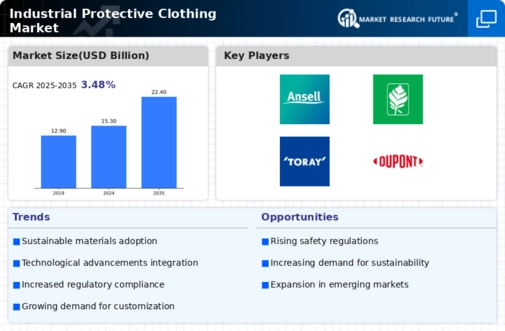Growth in Hazardous Industries
The expansion of hazardous industries is a significant factor propelling the Industrial Protective Clothing Market. Sectors such as chemical manufacturing, mining, and construction are experiencing growth, leading to an increased need for protective clothing to safeguard workers from various risks. As these industries expand, the demand for specialized protective gear that can withstand extreme conditions and provide adequate protection against chemical exposure, heat, and physical hazards is likely to rise. Market data indicates that the chemical industry alone is expected to see substantial growth, further driving the need for effective protective clothing solutions. This trend underscores the critical role of protective clothing in ensuring worker safety in high-risk environments.
Stringent Regulatory Frameworks
The implementation of stringent regulatory frameworks is a crucial driver for the Industrial Protective Clothing Market. Governments and regulatory bodies are establishing comprehensive safety standards that mandate the use of protective clothing in various sectors. These regulations are designed to minimize workplace accidents and ensure the safety of employees. For instance, industries such as oil and gas, construction, and manufacturing are subject to rigorous safety guidelines that necessitate the use of appropriate protective gear. This regulatory environment is fostering a robust demand for industrial protective clothing, as companies seek to comply with legal requirements and avoid potential penalties, thereby propelling market expansion.
Rising Awareness of Workplace Safety
The increasing emphasis on workplace safety is a pivotal driver for the Industrial Protective Clothing Market. Organizations across various sectors are recognizing the importance of safeguarding their employees from potential hazards. This heightened awareness is leading to a surge in demand for protective clothing, as companies strive to comply with safety regulations and enhance their safety protocols. According to recent data, the market for industrial protective clothing is projected to grow at a compound annual growth rate of approximately 6.5% over the next few years. This growth is indicative of the industry's response to the pressing need for improved safety measures, thereby reinforcing the significance of protective clothing in various work environments.
Technological Innovations in Fabric Production
Technological advancements in fabric production are significantly influencing the Industrial Protective Clothing Market. Innovations such as the development of lightweight, breathable, and durable materials are enhancing the functionality and comfort of protective clothing. These advancements not only improve the wearability of protective gear but also expand its applications across diverse industries, including construction, manufacturing, and healthcare. The integration of smart textiles, which can monitor environmental conditions and provide real-time data, is also gaining traction. As a result, the market is witnessing a shift towards more sophisticated protective clothing solutions that cater to the evolving needs of workers, thereby driving market growth.
Emphasis on Sustainability and Eco-Friendly Products
The growing emphasis on sustainability and eco-friendly products is shaping the Industrial Protective Clothing Market. As environmental concerns gain prominence, manufacturers are increasingly focusing on producing protective clothing made from sustainable materials. This shift not only addresses consumer demand for environmentally responsible products but also aligns with corporate sustainability goals. Companies are exploring biodegradable fabrics and recycling initiatives to reduce their environmental footprint. The market is witnessing a rise in demand for protective clothing that meets both safety standards and sustainability criteria. This trend is likely to continue, as organizations seek to enhance their brand image while ensuring the safety of their workforce.

















Leave a Comment